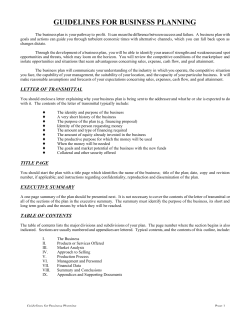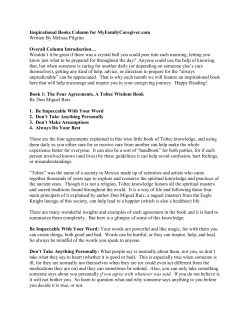
Macjo Arcade, Fourth Flour, Room 15E
Macjo Arcade, Fourth Flour, Room 15E Next to Tuskys Supermarket, Ongata Rongai P.O Box 3029 – 00200, Nairobi | Mobile: 0725-788400 | Email: infokenpro@gmail.com | Website: URL: www.kenpro.org BUSINESS PLAN FORMAT Compiled by Anthony M. Wanjohi Contact Details Name of Organization Organization Type Telephone (Mobile) E-mail Address City (Township) County Country Name of contact person E-mail of contact Person Title in the organization ii Executive Summary This is the thesis statement and states business plan objectives. Use the key word approach (who, what, where, when, why, how, how much) to summarize the following: • Your organization or institution. • Who your management is and what their strengths are. • What your objectives are and why you will be successful. • If you need a financing, why you need it, how much you need and how you intend to repay the loan or benefit the investor. Note: Do not write the executive summary (statement of purpose) until you have completed your business plan! It is a summary and reflects the contents of the finished plan. iii Table of Contents Contact Details ..................................................................................................... ii Executive Summary .......................................................................................... iii Table of Contents................................................................................................ iv 1.0 Organizational or Institutional Plan.................................................... 1 1.1 Mission ................................................................................................................. 1 1.2 Vision ................................................................................................................... 1 1.3 Services ................................................................................................................ 1 1.4 Location ............................................................................................................... 1 1.5 Legal Structure and Ownership ....................................................................... 1 1.6 The Organizational or Institutional Chart...................................................... 1 1.7 Management ....................................................................................................... 1 1.8 Personnel or Staff............................................................................................... 2 2.0 The Marketing Plan .................................................................................... 3 2.1 Market Analysis .................................................................................................. 3 2.2 Marketing Strategy ............................................................................................ 3 2.3 Assessment of Marketing Effectiveness ......................................................... 3 3.0 Financial Documents ................................................................................. 4 3.1 Pro Forma Cash Flow Statement (Budget)..................................................... 4 3.2 Three-Year Income Projection......................................................................... 4 3.3 Projected Balance Sheet.................................................................................... 4 3.4 Break-Even Analysis ......................................................................................... 4 4.0 Appendices: Supporting Documents................................................... 5 4.1 Personal Curriculum Vitae................................................................................ 5 4.2 Credit Reports .................................................................................................... 5 4.3 Copies of Leases, Mortgages, Purchase Agreements, etc............................. 5 4.4 Documents of Reference................................................................................... 5 4.5 Contracts ............................................................................................................. 5 4.6 Other Legal Documents .................................................................................... 5 iv 1.0 Organizational or Institutional Plan 1.1 Mission 1.2 Vision 1.3 Services • Describe your services. List future products or services you plan to provide. 1.4 Location • Describe your projected or current location. • Include legal agreements, utilities forecasts, etc. in Supporting Documents. 1.5 Legal Structure and Ownership • Describe the legal structure of the organization • List owners and/or corporate officers describing strengths (attach their CVs in the appendices). 1.6 The Organizational or Institutional Chart • Using an illustration, describe your organization’s structure 1.7 Management • List the people who are (or will be) managing the organization or institution. • Describe their skills and responsibilities • Project or indicate their salaries. 1 1.8 Personnel or Staff • How many employees will you or you have and in what positions? • What are the necessary qualifications? • How many hours will they work and at what wage? • Project future needs for adding employees. 1.9 Accounting & Legal Provisions Accounting: • What system will you set up for daily accounting? • Who will you use for a tax accountant? • Who will be responsible for periodic financial statement analysis? Legal: • Who will you retain for a lawyer? 1.10 Insurance • What kinds of insurance will you carry? (Property & Liability, Life & Health) • What will it cost and who will you use for a carrier? 1.11 Security • Address security in terms of inventory control and theft of information (online and offline). • Project related costs. 2 2.0 The Marketing Plan The Marketing Plan defines all of the components of your marketing strategy. You will address the details of your market analysis, advertising, and public relations campaigns. The Plan should also integrate traditional (offline) programs with new media (online) strategies. 2.1 Market Analysis • Target Market (identifies with demographics, psychographics, and niche market specifics). • Competition (describe major competitors assessing their strengths and weaknesses. • Market Trends (identify industry trends and customer trends). 2.2 Marketing Strategy • Packaging (quality considerations and packaging). • • Branding. Advertising Strategies (traditional, web/new media, long-term sponsorships). • Public Relations (online presence, events, press releases, interviews). • Networking (memberships and leadership positions). 2.3 Assessment of Marketing Effectiveness To be used after making periodic evaluations 3 3.0 Financial Documents This section of the business plan is the quantitative interpretation of everything you stated in the organizational and marketing plans. Do not do this part of your plan until you have finished those two sections. Financial documents are the records used to show past, current, and projected finances. The following are the major documents you will want to include in your Business Plan. The work is much easier if they are done in the order presented because they build on each other, utilizing information from the ones previously developed. 3.1 Pro Forma Cash Flow Statement (Budget) This document projects what your Business Plan means in terms of the money needed. It shows cash inflow and outflow over a period of time and is used for internal planning. It is of prime interest to the lender and shows how you intend to repay your loan. Cash flow statements show both how much and when cash must flow in and out of your business. 3.2 Three-Year Income Projection A Pro Forma Income Statement showing projections for your company for the next three years. Use the revenue and expense totals from the Pro Forma Cash Flow Statement for the 1st year's figures and project for the next two years according to expected economic and industry trends. 3.3 Projected Balance Sheet Projection of Assets, Liabilities, and Net Worth of your institution at end of next fiscal year. 3.4 Break-Even Analysis The break-even point is the point at which a company's expenses exactly match the sales or service volume. It can be expressed in: (1) Total revenue exactly offset by total expenses -or- (2) Total units of production (cost of which exactly equals the income derived by their sales). This analysis can be done either mathematically or graphically. Revenue and expense figures are drawn from the three-year income projection. Note: The following (G-J) are Actual Performance (Historical) Statements. They reflect the activity of your business in the past. If your business is new and has not yet begun operations: the financial section will end here and you will add a Personal Financial History. 4 4.0 Appendices: Supporting Documents This section of your plan will contain all of the records that back up the statements and decisions made in the three main parts of your business plan. The most common supporting documents are: 4.1 Personal Curriculum Vitae Include resumes for owners and management. A resume should be a one-page document. Include: Key Skills and competencies, educational background, professional affiliations and honors. 4.2 Credit Reports Business and personal from suppliers or wholesalers, credit bureaus, and banks (if any). 4.3 Copies of Leases, Mortgages, Purchase Agreements, etc. All agreements currently in force between your company and a leasing agency, mortgage company or other agency. 4.4 Documents of Reference Letters recommending you as being a reputable and reliable business person worthy of being considered a good risk (both business and personal references). 4.5 Contracts Include all business contracts, both completed and currently in force. (If any) 4.6 Other Legal Documents All legal papers pertaining to your legal structure, proprietary rights, insurance, etc. Limited partnership agreements, shipping contracts, etc. 5
© Copyright 2025





















